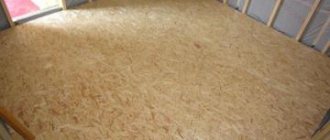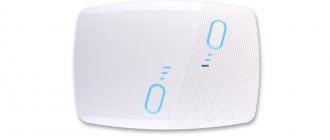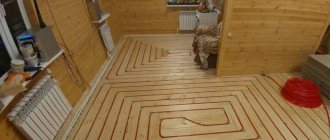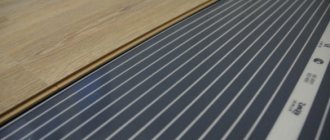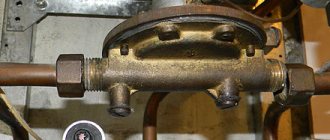On trading platforms, the range of heating radiators includes electric, water or combined equipment for wet rooms, which is also used for drying textiles. The heated towel rail is installed on the walls or floor with a connection to the wiring, heating or hot water supply system. Let's consider the features of installation of units depending on the heat source, the location of the pipes and the rules prescribed in SNiP.
Electric dryer Source pinimg.com
Overview of types of heated towel rails for baths
Classification of heated towel rails is carried out according to the coolant, installation method, shape, type of connection and materials of manufacture. So, the source of heat is electricity or a heating network. Depending on their location, there are wall-mounted, floor-mounted, stationary or rotary models. Design execution is based on the following standards:
- coil;
- steps:
- bowl;
- spiral.
The heated towel rail is connected to the electrical network or water supply diagonally, horizontally or vertically. For the production of water equipment, metal is used:
- Seamless stainless steel with walls greater than 3 mm and a diameter of ¾-1 inch copes with the pressure in the city heating network.
- Black steel is only permissible for autonomous systems, since the internal surface does not have anti-corrosion protection.
- Copper quickly acquires the temperature of the coolant, but the inner surface of the pipe must be insulated from direct contact with water.
- Brass is protected by a chrome layer, but is sensitive to pressure changes.
Copper radiator for the bathroom Source pechiexpert.ru
Electrical units are equipped with a heating element, which transfers thermal energy to the coolant liquid. This could be technical oil, antifreeze or water. Another option involves pulling a heating cable through the channels.
The dimensions of a water heated towel rail have a wide range of values depending on the design. Thus, U-shaped products are often 32 cm in height, ladders are 50-120 cm, and coils are up to 60 cm. The width of all products is in the range of 40-80 cm, which can be explained by the small dimensions of the bathroom and its purpose for drying small textiles.
An independent approach to the manufacture of a water heated towel rail allows the use of metal-plastic or polypropylene pipes. It is important to observe the restrictions on channel bending and the diameter, which must match or exceed that of the water supply.
Polypropylene pipe dryer Source beliashou.com
Combined products are connected to a seasonal central heating system and the electrical network. Such equipment provides heating of a damp room in the summer and in emergency situations at a heating station.
Combined dryer for wet rooms Source yandex.net
Installation of a combined model
Installing an electric heated towel rail requires special efforts. The main advantage of this installation is the continuous heating of the dryer at any time of the year. In addition, you can adjust the temperature here.
During the repair work, it is necessary to carry out additional wiring from the pipeline. This will save energy consumption in winter. At the end of the heating season, the electrical network is used.
The height of the heated towel rail from the floor should be from 65 to 100 cm. The higher the drying position for small items, the greater the heat transfer of the device.
As you can see, installing such a system requires special knowledge in the field of electricity. Photo installation instructions help to perform installation work correctly.
Building regulations
The height of the lower edge of the heated towel rail from the floor, based on SNiPs, is permissible at 90 cm, provided that it is an M-shaped coil or a ladder. The top edge should not be higher than 1.70 m. For a bowl, the value is 30 cm higher, and for the combined type 1 m. It is recommended to maintain a distance of 60 cm from the doorway and wall cabinets with shelves. The same applies to the mixer, bathtub, shower cabin. For electrical appliances, the minimum distance is 70 cm.
In small bathrooms, standards are often violated. This can be explained by the lack of standards in the construction and engineering of bathrooms. But there are requirements that must be met in any case:
- access to all communications must be open;
- using the dryer should be safe and comfortable;
- cannot be hung over a bathtub, but is acceptable over a sink or side-loading washing machine;
Electric rotary dryer Source dizainexpert.ru
- sockets must be grounded and connected to a separate circuit breaker; they can be installed indoors only if there is proper ventilation;
- the distance from the wall is maintained in accordance with the thermal expansion of the finishing material of the walls, but not less than 30-55 mm.
The dimensions of the heated towel rail are determined by the owner of the bathroom, but it is not recommended to violate the maximum distances between other objects. The manufacturer, in the product instructions, indicates the area that the product is designed to heat under certain conditions.
For example, at a coolant temperature of +70℃ and a heat output of the unit of 100 W, the serviced cubic capacity of the room will be equal to 2.5 cubic meters. m. Upon closer examination of the issue, the ratio of the volume of the bathroom and the parameters of the dryers approximately looks like this:
- up to 6 cubic meters – 50*40-60 cm;
- up to 8 cubic meters – 60*40-60 cm;
- up to 11 cubic meters – 80*40*60 cm;
- up to 14 cubic meters – 100*40-60 cm;
- more than 14 cubic meters – 120*40-80 cm.
Among other things, it is important to consider the weight of the equipment with components and coolant. Not every foundation can cope with the total load.
Consequences of incorrect calculation of the load of the unit on the wall Source filesonload.ru
See also: Catalog of companies that specialize in heating, water supply and sewerage systems
As a result, you will have to either strengthen the wall and floor, or choose a different design in terms of material, shape or size.
Next to the sink
A heated towel rail next to the sink is a functional solution for a small bathroom. Firstly, everyone uses the sink many times a day (especially in the current pandemic conditions). Therefore, dry towels should always be at hand. As a rule, even in small bathrooms there is a little space next to the sink - you can hang a compact vertical device there.
Installation of an electric heated towel rail
Installation of electrical equipment in a wet area requires protective measures to ensure safe use. This is a separate RCD, grounding and the installation height of the heated towel rail socket is at least 70 cm from the floor. The connection is made by installing the latter inside or outside the bathroom.
The electrical socket must be protected by a sealed housing and a cover with a rubber seal. It is permissible to place the device on a wall with minimal moisture load, but not bordering the street. This is explained by the difference in temperatures, due to which there is a high possibility of condensation forming in the seat.
The most reliable option is to lay serviced communications in the body of the wall.
Hidden installation of electrical wiring with socket Source mainavi.ru
To do this, grooves and recesses are formed for the socket, through holes for bringing the latter out. Filling the voids with plaster mortar and finishing materials will protect the wiring from contact with moisture. External installation with a high degree of insulation is also acceptable. The cable for installing the heated towel rail is placed at a height of more than 10 cm from the floor, so that it later leads to a short circuit.
Connection procedure
The cable, machine and socket are selected with a small power reserve relative to the connected equipment. So, for example, 1.8 kW is divided by 220 V, and 8.2 A is obtained. The cable must have a copper conductor cross-section of at least 1 sq. mm. With respect to furniture they maintain 750 mm, corners - 300 mm, floors - 200 mm.
The heated towel rails to be hung are applied to the area permissible for installation, and the position of the brackets is noted. Mounting holes are drilled and the equipment is fixed to the wall. Stationary floor models are fixed to the base according to the same scheme. Next, connect to the power source. The socket should be at a distance of 25-35 cm to the side of the device.
Correct location of the outlet for the dryer in the bathroom Source maxi-svet.by
Is it possible to hang a heated towel rail above a washing machine?
In small rooms, every centimeter counts, so sometimes it is necessary to install the device above the washing machine; there is simply no other place.
This arrangement of the heated towel rail may be unsafe. Therefore, you need to retreat at least 60 cm from the surface of the device. Otherwise, there will be a risk of fire due to overheating. But even if a fire does not happen, prolonged exposure to high temperatures (60 degrees and above) will negatively affect the operation of the machine. This is especially true for front-loading devices, the open lid of which will touch the heated towel rail. Also, drying things will create increased humidity, which will lead to corrosion of the machine. The Praktika online store offers electric and water heated towel rails from trusted manufacturers. The range includes models for small and spacious bathrooms. Request a call back to get advice from a manager and discuss delivery conditions in St. Petersburg or the Leningrad region.
Installation of a water heated towel rail
The installation of a heated towel rail with water coolant is pre-coordinated with utility services. This is necessary to determine the time to turn off the water supply service. The unit is connected to general communications in the same way as the developer did. Reworking the system can lead to changes in pressure and temperature in the network, and less often to depressurization of the main line.
Water models operate by connecting to a heating network or hot water supply system. In this way, the coolant circulates through the pipes of the heated towel rail. The choice of equipment is determined by the pressure in the service line:
- old stock – 5-7 atm;
- new buildings – up to 10 atm;
- autonomous system – as a rule, below 1.5 Atm.
It is also necessary to read the recommendations from the manufacturer. So, there are models that are not allowed to be connected to the hot water supply. In this case, units intended for installation in the water supply system can be embedded in the heating circuit. And there are coils for installation in any water main.
Connecting equipment to hot water supply Source mirvannaja.ru
Before connecting a heated towel rail to a hot water supply or domestic hot water system, you need to familiarize yourself with the pros and cons of the solutions. So, in the first case, there is a seasonal dependence and the presence of a system with a water coolant. But the circulation of the environment occurs around the clock. In the second case, the heating of the unit occurs during active use of hot water, which is why the pipes are noticeably colder at night than during the day. But the equipment works all year round.
Replacing a heated towel rail in a centrally serviced building with an analogue from the developer can be done independently. It will be enough to agree on the suspension of water circulation. If the devices differ from the original ones, then the drafting and approval of documents by the housing and communal services will be required.
To understand how to connect a heated towel rail, you need to familiarize yourself with the general requirements:
- narrowing the diameter of the coolant source is unacceptable;
- a bypass is installed between the riser or water supply and the unit;
Location of the bypass in front of the heated towel rail Source mhremont.ru
installation of shut-off valves on the jumper and in the area between it and the supply main is excluded.
The bypass will ensure that water circulation is maintained in the central system in the event of a heated towel rail failure. If you install ball valves in front of the equipment, it will be possible to repair or replace the device without coordinating the event with utility services.
Water device installation process
The first step is to assemble it correctly. Next, it is important to follow the basic rules for installing a heated towel rail. Shut-off valves with detachable connections are installed on the supply line. In the future, they will ensure the smooth replacement of the old model with a more modern one.
Installation of a bypass using pipes and special tees. Here you will need three additional valves. Two of them are installed at the top and bottom of the heated towel rail and one on the pipeline itself to stop the water supply.
The final step will be to fill the device with water from the central water supply system. To do this, open all three taps.
Video description
The video discusses in detail the advantages of installing a bypass:
Installation diagrams for a water heated towel rail
For most models, the working medium is supplied through the top outlet, and the outlet is provided from the bottom. This is a universal approach that can be applied to any design. In addition, there are other advantages:
- efficiency does not depend on the pressure in the serviced network and the direction of water movement;
- air does not accumulate in the pipes of the unit;
- the distance from the highway is determined by the desire of the bathroom owner.
Lateral connection of drying equipment Source polotenhik.ru
Let's consider how to install a heated towel rail with a lateral or diagonal connection so that the equipment functions correctly:
- The slope of the pipes should be 20-30 mm when water enters towards the heated towel rail, and when exiting towards the main line. The exception is pipes with a diameter of 32 mm at a distance of up to 200 cm. Then it is permissible to maintain a horizontal level.
- The supply contours must only be level. Any curvature will provoke the formation of air with subsequent disruption of the natural circulation of fluid.
- Connecting pipes for devices with steel lines can be at least ¾ inch in diameter. For reinforced polypropylene the limit is 25 mm.
For hidden connections, experts recommend resorting to thermal insulation measures. This applies to plastic pipelines. For this purpose, polystyrene foam sleeves or polyurethane foam shells are often used. The materials are resistant to temperature changes, moisture, inert to biological damage and serve for a long time.
Insulation of connecting circuits and water supply Source montagtrub.ru
Features of installation of electric models
Unlike water models, electric dryers can be installed anywhere, since they do not depend on the location of heating pipes and hot water supply. In this case, special attention should be paid to the quality of the electrical wiring.
Requirements for installation of electric heated towel rails:
- The installation location is selected taking into account the level of protection of the device from moisture. The distance to the bathroom or washbasin is at least 60 cm.
- The minimum distance to the floor is 20 cm, to the wall – 30 cm, to the surface of furniture – 75 cm.
- The heating device must not be placed directly under the outlet.
Connection to the electrical network is carried out in accordance with the international standard NFC-15-100.
The optimal location is zone No. 3. When installed in zone No. 2, protection of the device from splashes is required (+)
Electrical wiring under the heated towel rail is carried out in compliance with electrical safety standards in rooms with high humidity:
- connection via a three-wire cable with grounding;
- Only hidden electrical wiring is allowed;
- the socket must have a rubber seal and a cover covering the contact holes;
- Copper wires of the VVGng and VVGng-LS brands are used for the electrical network.
A prerequisite for the installation and operation of electrical appliances is the use of an RCD that turns off the device when the current operating characteristics are exceeded.
Oil heated towel rails require rigid fixation, while cable radiators can be installed in any position
Video description
From the video you can learn how to connect a dryer at a great distance from the riser:
How to properly connect a heated towel rail to a hot water riser using fittings:
- The taps are installed between the pipes and the dryer. If there is already a thread on them, then it is worth correcting it with a die to ensure a tight connection.
- It is important to secure the fittings correctly here. They are prefabricated, so there is a seam on the body. It should be directed in the direction of the flow.
- Flax is used for compaction.
- The final fixation after manual tightening is carried out with a key ¼-½ full turn.
If you violate these simple rules, a leak will soon appear, a seam will rupture, or a nut will burst.
The last thing you need to do before launching the system is testing. To do this, turn on the riser for a short period of time. This will be enough to determine the tightness of the structure. If everything is in order, then you can put the heated towel rail into operation. Otherwise, eliminate the deficiencies and repeat the test again.
Leak detected during system testing Source www.tproekt.com
How to decorate an old heated towel rail
1. To begin with, we found a material suitable for our purpose. This is a chrome-plated furniture support pipe - its diameter and size suited us quite well!
The length was enough to cut three fragments of the required size, which we did.
2. We measured the required areas on the coil in the shape of the letter “P” and cut off three pieces of new pipe.
3.Then each of the segments was sawn along its entire length.
4. We put the finished element on the pipe. The slot must first be widened. But this must be done carefully so as not to bend or scratch the chrome surface of our decorative part. To do this, we inserted a plug into the cut and carefully pushed our element onto the heated towel rail area.
5.Now we need to press our cover closer to the coil pipe
Here we used clamps. We lay a wooden backing so as not to scratch the mirror surface and tighten the clamp screw to the level we need.
6.To securely fasten our decorative element to the pipe, we will need pipe clamps (worm clamp)
We specially selected the clamp in the desired color to match chrome.
7. Apply the clamp
8. And tighten it by placing it on the edge of the chrome section
9. Using two clamps along the edges of the lining, we tightly fix our decorative pipe on the heated towel rail area.
10.We dressed and secured all other parts of our chrome decor in the same way.
We ended up with a significant mirror surface in our bathroom, just as we had planned. We were able to update an old fly dryer in our bathroom.
11. It remains to close (decorate) the angles of rotation of the coil. For this, we also planned to select a part with a mirror coating. But we only came across this element
Branch (elbow) made of gray plastic. We selected a bend of the required diameter and at the angle we needed.
12. A special slit was cut out on the side of the outlet to fit onto the pipe
13.And installed it on the corner section of the U-shaped coil
14. All our design work ended up looking like this.
15. Of course, plastic parts can be additionally painted with silver (chrome) paint. These are found among car paints for updating chrome car parts.
But we decided to leave everything as it is for now.
Our decorative coil, despite its non-standard appearance, perfectly copes with its main functions - drying towels and maintaining warmth in the bathroom.
Everyone who saw our creative work for the first time was sure that in front of them was some kind of special device for heating or insulation. Mostly, our experts liked our life hack.
Briefly about the main thing
Bathroom heated towel rails are made from various metals. This determines the permissible pressure that can be created inside the product.
The heat source can be electricity, hot water supply or a heating system. Depending on this, it is necessary to pull a cable with a terminal socket or install connecting circuits between the riser and the equipment.
The choice of dryer is based on material, coolant and size. The latter is justified by building codes, according to which it is necessary to maintain specific distances to plumbing fixtures, floors, and furniture.
There are several schemes for connecting units: lateral, diagonal, horizontal (top or bottom). In the case of liquid coolant, it is important to monitor the location of the outlets on the riser in relation to the pipes on the heated towel rail. They should be straight or with vertical inserts, but without loops. Then the independent circulation of water will not be disrupted and air will not form in the system.
When replacing a water heated towel rail, you must contact utility services to turn off the riser and obtain permission to install the selected model. Not always, but in some cases, drafting and approval of project documentation is required.
Location options
When apartment residents make renovations, the question often arises: where to hang a heated towel rail in the bathroom. It is impossible to answer it unequivocally; everyone chooses a comfortable position for themselves.
If you install a water version of the device into a heating or water supply system, you need to focus on the pipes. Usually they are located opposite each other. Most often, a bathtub and sink are located next to the water supply pipes. Hanging a towel rail over them is not very convenient, but some people do it.
If you have to connect a water dryer to heating pipes, then this is usually done opposite the bathtub. The most convenient location for towels is above the washing machine. This is exactly how it is located in most modern apartments.
One of the worst placement options would be to install the device above the toilet in a combined bathroom. The disadvantage is obvious: careless movement can cause towels to slip into the toilet.
Another bad place would be the space above the bathroom. Splashes of water will fly onto the towels, and the structure will not be able to fully perform its functions.
When choosing an installation scheme for a water heated towel rail, in addition to convenience, it is necessary to take into account the water pressure in the system. If you take it far from the riser, the pressure may not be enough, then the structure will not heat up.
Original coloring for masking communications ↑
Most often, they try to cover the coil not because it is an old model, but because of its ugly surface. Many years of layers of paint + rust can turn perfectly smooth metal into a shapeless, lumpy “something” that cannot be corrected with ordinary painting.
This type of “towel” will ruin anyone’s mood.
It is worth approaching the issue with humor and creating a coil of an unusual, avant-garde look. Making an art object is simple:
- buy paper for covering windows with a sticky layer applied;
- cut the bay in half with a sharp knife to get narrower strips:
- wrap the entire heated towel rail with this paper, laying it in even turns;
- the resulting surface is coated with any decorative paint.
If the coil is installed almost flush against the wall, then the roll of paper will not fit through the narrow space when winding. Then you will have to tear off individual strips and rewind them.
Pasting paper
Keep in mind that your appliance will heat the bathroom worse, and the laundry will dry more slowly
You can not wrap the entire pipe, but wrap individual sections at equal intervals. The result will be a decor similar to a rope with knots. All you have to do is paint the main part in one color, and the wound “bumps” in a contrasting color. When you decide to move, simply cut off the layers of paper with a knife and use the device to return to their original state.

